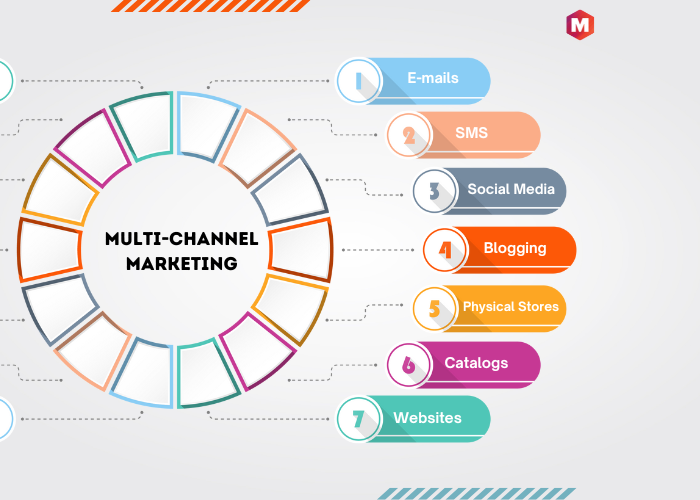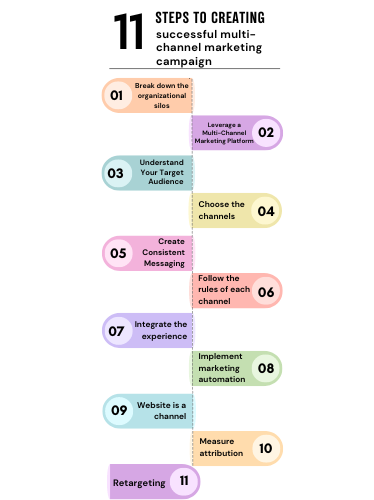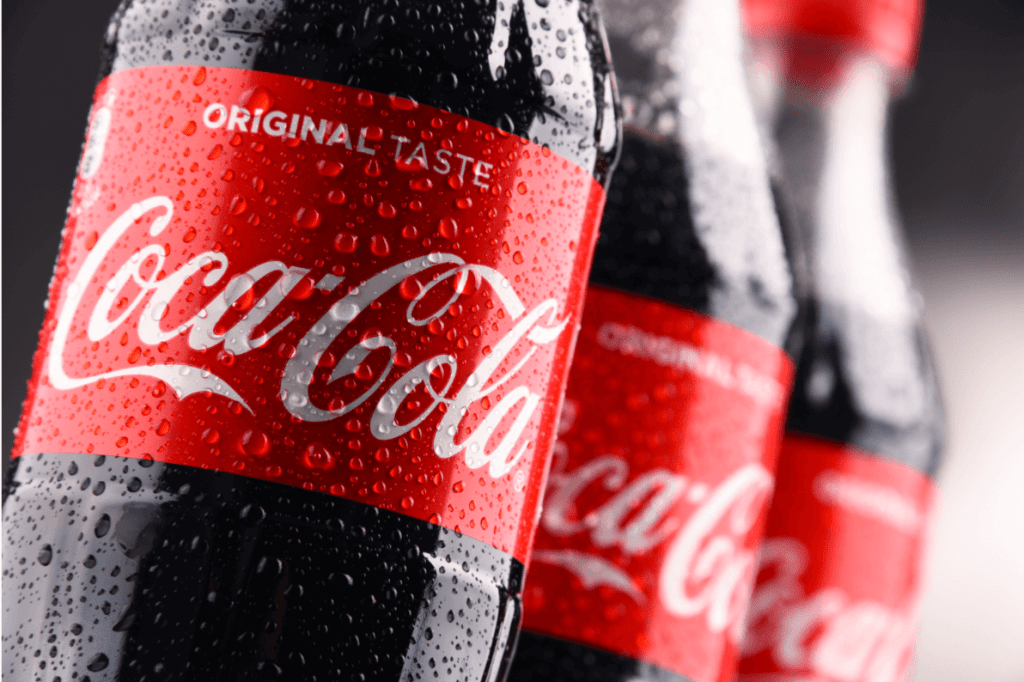Table of Contents
What is multi-channel Marketing?
Multi-channel marketing is the practice of interacting with and promoting prospects and customers via multiple online and offline communication channels. Customer interaction involves both indirect and direct communication channels.
Multi-channel marketing is the process of marketing to customers through multiple channels. The goal is to reach customers where they are most active and engaged. This allows businesses to create a more holistic and complete customer experience.
Marketing through multiple channels is key because your customers are active on various platforms. They’re not just limited to one site, and if you need more convincing, remember that multichannel shoppers usually spend three to four times more money than those who stick to only one channel.
Multi-channel marketing can be done through various channels, including, but not limited to, social media, email, direct mail, brick-and-mortar stores, and online marketplaces. Each of these channels offers a unique way to reach and engage customers.
Importance of Multi-Channel Marketing
Multi-channel marketing is vital because it allows businesses to stay where their customers are, virtually everywhere. Statistics support this assumption, indicating that customers who connect across many channels spend three to four times more than single-channel users.
With the growth of market dynamics, consumers are increasingly in control of the purchasing process, outweighing marketers due to the variety of channels through which they can receive information.
Technology has greatly expanded the techniques and modes of reaching out to customers. As the number of such channels grows, multi-channel marketing becomes increasingly relevant, not just as a good technique but also as an essential one.
Key Steps to Creating a Successful Multi-Channel Marketing Campaign
1. Break Down Organizational Silos & Identify your buyer persona
The first step to creating a successful Multi-Channel Marketing campaign is to break down the organizational silos within your company. This means that you need to identify the buyer persona for your product or service. Once you have identified the buyer persona, you must create a campaign tailored to their needs and interests.
2. Leverage a Multi-Channel Marketing Platform
The second step to creating a successful Multi-Channel Marketing campaign is to leverage a Multi-Channel Marketing Platform. A Multi-Channel Marketing Platform will allow you to manage your marketing campaigns across all channels from one central location. This will save you time and money by reducing the duplication of effort across multiple channels.
3. Understand Your Target Audience
The third step to creating a successful Multi-Channel Marketing campaign is understanding your target audience. You must research your target audience and understand their needs and interests. Once you have a good understanding of your target audience, you can create a campaign that is tailored to their specific needs.
4. Choose the channels you want to target
The fourth step to creating a successful Multi-Channel Marketing campaign is to choose the channels you want to target. Many different marketing channels are available, so choosing the ones that will reach your target audience is important. Some of the most popular marketing channels include social media, email, direct mail, and online marketplaces.
5. Create Consistent Messaging
The fifth step to creating a successful Multi-Channel Marketing campaign is to create consistent messaging across all your channels. This means you must have a clear and concise message tailored to your target audience. Your message should be the same across all channels so your prospects and customers can easily understand it.
6. Play by the rules of each channel
The sixth step to creating a successful multi-channel marketing campaign is to follow the rules of each channel. Each marketing channel has its own set of rules and guidelines, so it is important to follow them to be successful. Please do so to avoid your campaigns being banned or removed from the platform.
7. Figure out how you’ll integrate the experience across channels
The seventh step to creating a successful Multi-Channel Marketing campaign is to figure out how you will integrate the experience across channels. This means you must consider how your prospects and customers will interact with your campaigns across all your channels. You need to ensure the experience is seamless and consistent across all channels.
8. Implement marketing automation
Implementing marketing automation is the eighth step to creating a successful Multi-Channel Marketing campaign. Marketing automation will allow you to automate your marketing tasks so that you can focus on other aspects of your business. It is important to note that marketing automation does not replace the need for human interaction, but it can help to save time and money.
9. Keep in mind that your website is a channel
The ninth step to creating a successful Multi-Channel Marketing campaign is to remember that your website is a channel. This means you must treat your website separately from your other channels. Your website should be optimized for search engine optimization (SEO) so your target audience can easily find it.
10. Plan how you’ll measure attribution
The tenth step to creating a successful Multi-Channel Marketing campaign is to plan how you will measure attribution. Attribution is the process of assigning value to each of your marketing channels so that you can determine which ones are performing the best. There are many different attribution models, so choosing the one that best fits your business is important.
11. Invest in retargeting
The eleventh step to creating a successful Multi-Channel Marketing campaign is to invest in retargeting. Retargeting is an online marketing tool that lets you advertise to individuals who have already shown interest in what you’re selling. This is an effective way to increase brand awareness and conversion rates.
Marketing Channels Used in Multi-channel Campaigns
- Email: You can use email to reach your target audience through newsletters, product announcements, and special offers.
- SMS: You can use SMS to reach your target audience with text messages.
- Push Notifications: You can use push notifications to reach your target audience with timely messages.
- Direct Mail: You can use direct mail to reach your target audience with physical mailers.
- Social Media: You can use social media platforms such as Facebook, Twitter, and Instagram to reach your target audience.
- Blogging: You can use blogging to reach your target audience through writing informative articles.
- TV: You can use TV to reach your target audience through commercials and infomercials.
- Websites: You can use websites to reach your target audience through digital marketing, banner ads, and pop-ups.
- Physical Stores: You can use physical stores to reach your target audience through in-store promotions.
- Catalogs: You can use catalogs to reach your target audience through mailed brochures.
Benefits of Multi-Channel Marketing
1. Expanded Reach: Multi-channel marketing allows you to reach a larger audience than you would with a single channel. This is because you can target multiple channels at the same time.
2. Increased Engagement: Multi-channel marketing increases engagement with your target audience. By using multiple channels, you can provide a more engaging experience.
3. Reach Consumers on Their Preferred Channel: Multi-Channel Marketing allows you to reach consumers on their preferred channel. This is important because it allows you to meet them where they are already spending their time.
4. Combined Channels are More Effective: Multi-Channel Marketing allows you to combine multiple channels into one campaign. This is important because it allows you to create a more effective campaign. Multi-channel marketing can be a very effective way to reach your target audience.
What are some common mistakes made with Multi-Channel Marketing?
1. Not Defining Your Target Audience: One of the most common mistakes with Multi-Channel Marketing is not defining your target audience. This mistake will cause you to waste time and money on marketing channels that will not reach your desired consumers.
2. Not Determining Your Goals: Another common mistake with Multi-Channel Marketing is not determining your goals. This is a mistake because you will not be able to measure the success of your campaign if you do not have specific goals in mind.
3. Not Testing Your Campaign: Another common mistake with Multi-Channel Marketing is not testing your campaign. This is a mistake because you cannot determine what is and is not working if you do not test your campaign.
4. Not Measuring Your Results: The final common mistake with Multi-Channel Marketing is not measuring your results. This is a mistake because you will not be able to determine the success of your campaign if you do not measure your results.
Challenges
1. Targeted messaging: One of the challenges with Multi-Channel Marketing is targeted messaging. You need to ensure your message is relevant to each channel.
2. Highly choreographed campaigns: Another challenge with Multi-Channel Marketing is highly choreographed campaigns. This is because you need to ensure that each channel works together in harmony.
3. Marketing response attribution: Another challenge with Multi-Channel Marketing is marketing response attribution. You need to be able to attribute the success of your campaign to each channel.
4. Efficient Management: The final challenge with Multi-Channel Marketing is efficient management. This is because you need to be able to manage all of your channels efficiently to be successful.
5. Leveraging Marketing Analytics: Multi-channel marketing can be very effective, but it is important to leverage marketing analytics to be successful. You need to be able to track the success of your campaign and make necessary changes.
6. Keeping Up With Innovations: Multi-channel marketing can be very effective, but it is important to keep up with innovations. New channels are constantly being created, and you need to be able to adapt your campaign accordingly.
RACE Framework and SOSTAC®
The RACE Framework is a helpful tool that can be used to create and implement a Multi-Channel Marketing campaign. The RACE Framework stands for Reach, Act, Convert, Engage.
The SOSTAC® framework is another helpful tool that can be used to create and implement a Multi-Channel Marketing campaign. The SOSTAC® framework stands for Situation, Objective, Strategy, Tactics, Action, and Control.
Both of these frameworks help create and implement a Multi-Channel Marketing campaign. However, deciding which one will work best for your business is up to you.
Multi-Channel vs. Cross Channel Marketing
Multi-channel marketing strategy is the process of marketing to customers through multiple channels. This can include a variety of online and offline channels, such as social media, email, SMS, direct mail, and more.
A successful multichannel marketing strategy takes into account the customer’s journey and touchpoints across all channels. This means understanding what data is being collected at each stage and using that data to create targeted and relevant messages that will lead to conversions.
Cross-channel marketing is a term you may hear used interchangeably with multi-channel marketing. However, cross-channel marketing specifically refers to tracking a customer’s journey across all channels and using that customer data to create a more personalized experience.
Both multi-channel and cross-channel marketing require a careful balance of offline and online channels to succeed. Too much focus on one channel can result in lost opportunities elsewhere. The best way to find the right mix is to experiment and test different channels and strategies to see what works best for your business.
Example of Multi-Channel Marketing
Coca-Cola is a successful company that uses Multi-Channel Marketing to reach its target audience. Coca-Cola uses a variety of channels, such as television, radio, print, and online.
Coca-Cola’s Multi-Channel Marketing campaign is an example of a well-executed campaign. Coca-Cola was able to reach its target audience by using a variety of channels, and its success shows that Multi-Channel Marketing can be an effective way to reach your target audience.
1. Amazon
Amazon uses various channels to reach its customers, including its website, mobile app, email newsletters, and even physical stores like Amazon Books and Amazon Go. Additionally, Amazon leverages its Alexa voice assistant as a marketing channel, allowing customers to shop using voice commands. This multi-channel approach ensures that Amazon is accessible to customers through their preferred method of shopping.
2. Starbucks
Starbucks employs a multi-channel marketing strategy, including its stores, mobile app, website, and social media platforms. The Starbucks mobile app is particularly noteworthy for integrating mobile payments and rewards, making it a crucial part of the customer experience. This app allows customers to order ahead, pay in-store, and earn rewards, seamlessly bridging the gap between the digital and physical experience.
3. Nike
Nike utilizes a multi-channel approach by selling its products through retail stores, its website, mobile app, and third-party retailers. Nike’s mobile app allows customers to shop for products and offers personalized training programs and product recommendations.
The brand’s use of social media platforms for engagement and marketing, along with innovative uses of technology in physical stores, creates a cohesive and integrated customer experience across channels.
4. Apple
Apple’s multi-channel strategy includes its website, Apple Stores, the Apple Store app, and customer support channels like the Genius Bar. The brand ensures a high-quality, consistent experience across these channels, each providing a unique value proposition. For instance, the Apple Stores offer a hands-on experience with products, while the app facilitates easy shopping and appointment bookings.
5. IKEA
IKEA employs a multi-channel strategy integrating its catalog, website, mobile app, and physical stores. The IKEA catalog in print and digital forms serves as a significant marketing tool, while the website and app offer planning tools and product visualization features. These digital channels complement IKEA’s in-store experience, offering a comprehensive journey from inspiration to purchase.
These examples show how brands use multiple channels to sell their products and create a unified and seamless customer experience that enhances brand loyalty and engagement.
Conclusion!
Multi-channel marketing campaigns are the process of spanning multiple channels to reach marketing messages to potential customers. It can be used to improve customer loyalty and increase sales by better understanding how customers interact with marketing efforts. Multi-Channel Marketing Attribution can help identify the most effective channels for reaching target audiences.
When implemented correctly, multichannel marketing communications can be a powerful tool for reaching potential customers. By better understanding how customers interact with marketing efforts, multichannel marketing messages can help improve customer loyalty and increase sales.
Used correctly, multi-channel marketing can be an excellent way to reach customers through various channels in a customer journey and optimize lead generations, conversions, and sales.
What are your thoughts on multi-channel marketing? Have you used it before? What were your results? Let us know in the comments below!
Frequently Asked Questions about Multi-Channel Marketing
Why is multi-channel marketing effective?
Multi-channel marketing leverages diverse platforms to enhance the visibility and impact of your promotional efforts. Using only one medium can limit your campaign’s effectiveness, as consumers nowadays engage with multiple channels.
Implementing a multi-channel approach broadens your campaigns’ scope and paves the way for advanced techniques like cross-channel marketing for even greater efficiency.
What does multi-channel mean?
Multi-channel marketing involves engaging with your audience through various platforms, like newsletters, blogging, engaging posts on platforms like Instagram or Twitter, brochures, SMS, billboards, and online videos.
By utilizing diverse communication methods, businesses can ensure more robust interaction with their audience, creating a holistic marketing effort.
Liked this post? Check out the complete series on Marketing




Good day sir,
What are the things needed to get or put in place for mulch-channel referral marketing.
Do I need Satellite Dish Covers?
In this age of multiple screens, multi-channel marketing is a fact of life. As businesses communicating with customers, we need to understand the challenges and benefits of multi-channel marketing and tailor our strategies accordingly.
Running a multi channel marketing has a lot of challenges, but when I started using ActiveTrail it helps me a lot to make my marketing more easier than before, I really recommend this platform.
Very helpful